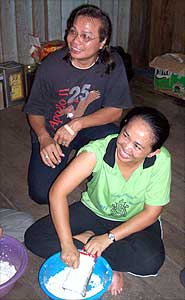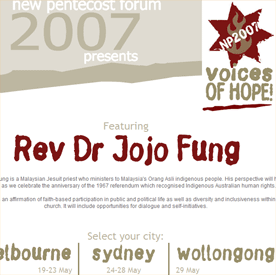 Forty years ago this Sunday, an overwhelming majority of Australians recognised the human rights of Indigenous Australians in the 1967 referendum. This paper calls for a retrospective recognition that the Aboriginal dignity does not depend a priori on a referendum of the dominant white society.
Forty years ago this Sunday, an overwhelming majority of Australians recognised the human rights of Indigenous Australians in the 1967 referendum. This paper calls for a retrospective recognition that the Aboriginal dignity does not depend a priori on a referendum of the dominant white society.
On the one hand, the anniversary should motivate us to seek a reversal of all policies that aim to counter indigenous cultures and religiosity. On the other, it can energise us to lend a helping hand to sustain cultural and religious practices that contribute to the flourishing of the Aboriginal communities.
In the wider context of the world's indigenous peoples, Aboriginal dignity is a primordial given. It is based on the ritualistic celebration of Aboriginal festivities and passages of life. Rituals and shamanic experiences constitute an existential DNA fabric of aboriginal human dignity.
I have written about my own experience of shamanic rituals in Malaysia. I describe this as "subversive space", in that it subverts the systemic erasure of Aboriginal cultures and religiosity. Indigenous religion can be outlawed, but not outlived. The shamanic world is about transcendental realities known as the sacred world of spirits. As such, the spirits enable the aboriginal communities to maintain a certain power over hegemonic might that not only constitutes Aboriginal dignity, but preserves and promotes the dignity of one's neighbours.
The shift in the regional and global perception of Aboriginal dignity and rights was evident before and after the UN Year and Decade of Indigenous Peoples in 1993, and 1994-2004 respectively. This shift was made possible by the local and regional efforts of the Aboriginal subaltern movements around the world. The Australian Aboriginal movements no less, have contributed their share to the ripple effects of the regional and global flow of heightened Aboriginal dignity.
The systemic closure and erasure of indigenous cultural and religious beliefs and practices is common in any colonised society. US ethnobotanist Mark J. Plotkin cites Zimbabwe's Witchcraft Suppression Act of 1899, and points out that North American Indians, who have blended Christianity with their native beliefs, still struggle to be allowed to consume peyote, a traditional part of their religious rituals. He has further examples from Indonesia and other countries including Colombia, in which indigenous practices are branded as blasphemous according to the Christian world view.
An Aboriginal community known as Semai, in the central part of the Malaysian peninsula, is in conflict with state authorities over land that has been nominated for annexation for a botanical park. Although the community is having to resort to the courts to preserve their ownership of the land, the struggle also includes acts of communal ritual.
On 22 March this year, I witnessed the communal prayer known as "sewang". I went with community spokesperson Tijah over to the house of shaman Pak Ipan, at about 10.45pm. Upon arrival, we were told that Pak Ipan was invited over to one of the participants' house to shamanise (known in Semai as "jumpi") because he was suffering from a "neck-pain." (Malay: sakit leher). The ritual proceeded, and afterwards the Pak Ipan explained that the prayer was inextricably linked to the negotiation process about the use of their land, which was scheduled to take place two days later.
 This current subaltern narrative from the Semai aboriginal community demonstrates that the dignity of the Aboriginal community is indelibly rooted at the symbolic level in which rituals such as sewang are a vital expression of the inalienable dignity of the Aboriginal peoples. This symbolic dimension is a subversive space in which human efforts, when infused with the shamanic power of the spirits, subvert the very powers that are attempting to undermine them. Therefore the subverted victims become the subverting agents in the very space when the symbolic and the everyday are fused into a unitary seamless whole.
This current subaltern narrative from the Semai aboriginal community demonstrates that the dignity of the Aboriginal community is indelibly rooted at the symbolic level in which rituals such as sewang are a vital expression of the inalienable dignity of the Aboriginal peoples. This symbolic dimension is a subversive space in which human efforts, when infused with the shamanic power of the spirits, subvert the very powers that are attempting to undermine them. Therefore the subverted victims become the subverting agents in the very space when the symbolic and the everyday are fused into a unitary seamless whole.
To conclude, I can say that the heightened local, regional and global flow of consciousness that promotes aboriginal dignity is based on the increasing appreciation of the capacity within Aboriginal communities and their cultural and religions traditions to assert their subversive spaces in the exercise of their collective memory. That is, Aboriginal dignity is firmly grounded in Aboriginal cultures and religiosity, and more particularly in Aboriginal shamanism. The differences occasioned by the gaps in rationality and logic divide us. Yet the common experiences of the shamanic world of spirits enable the differences to be celebrated, in order to foster a sense of a unifying solidarity among all.
- Dr Jojo Fung is a Malaysian Jesuit priest who ministers to Malaysia's Orang Asli indigenous people. He is keynote speaker at the New Pentecost Forum (Melbourne 19-23 May, Sydney 24-28 May, Wollongong 29 May).